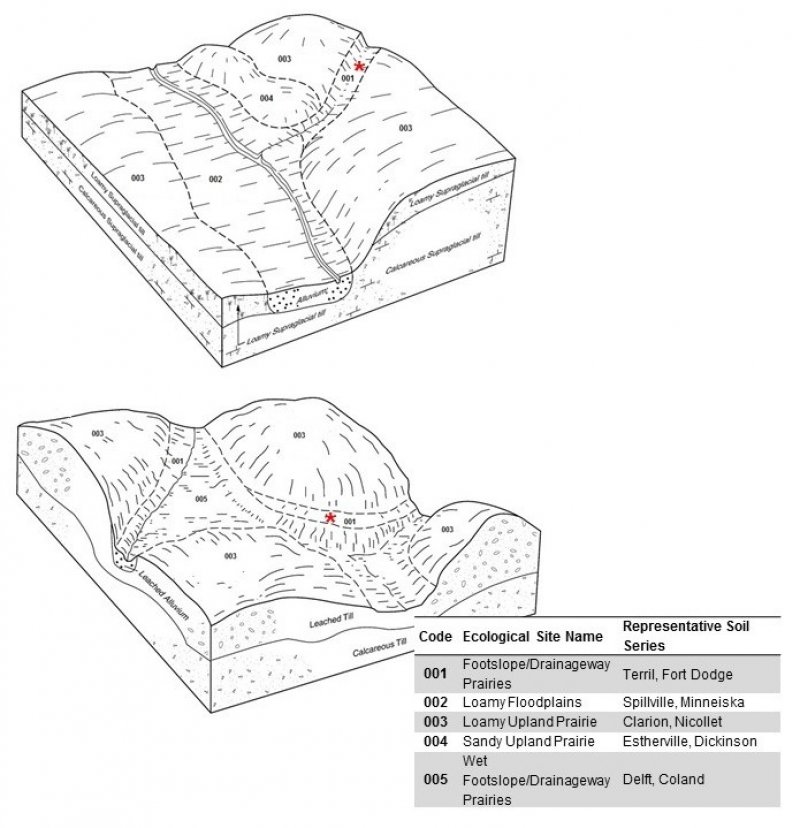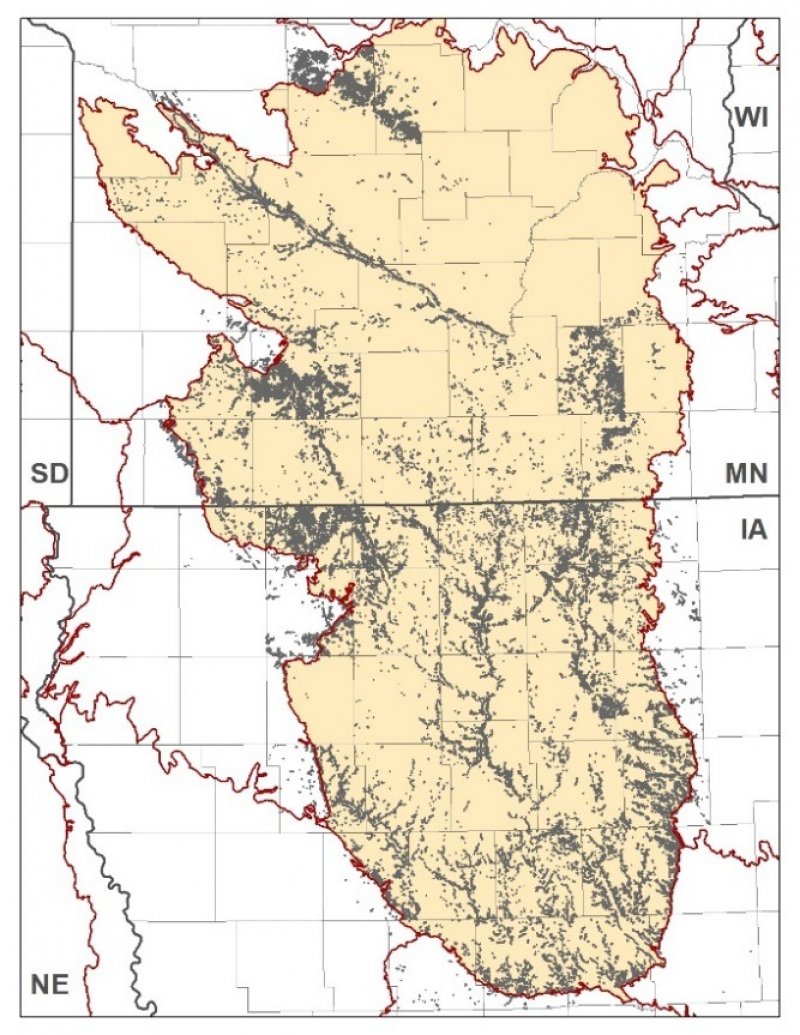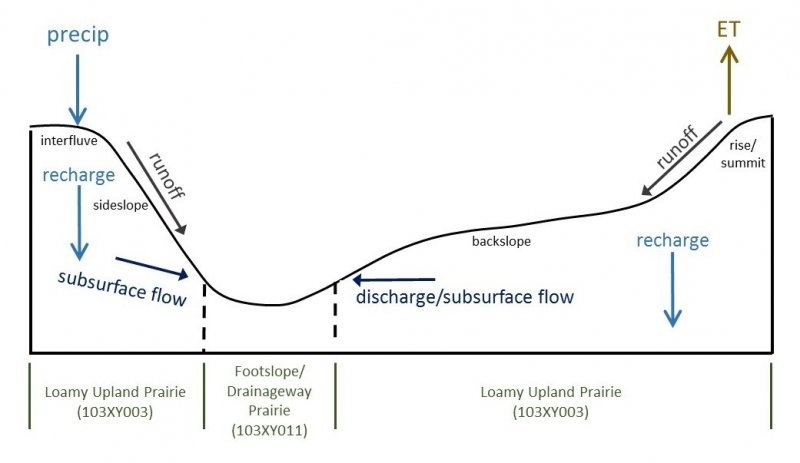Ecological dynamics
The Footslope/Drainageway Prairies ecological site is characterized by two states: the Reference State (native prairie) and the Tillage State. In this model, two plant communities exist in the Reference State and are characterized by different fire return intervals. The mechanism of change between communities is fire frequency and the resulting effects fire has on the plant community. Grazing and drought can also be a triggers for change on this ecological site. The Tillage State describes areas that have been tilled and may have modified hydrology (ditching, tiling). Two communities make up the Tillage State: the Row Crop Community and the Seeded Grassland Community. Some areas of this ecological site are wooded; however, the percentage of acreage in MLRA 103 is small, so this community is not described within the current state and transition model.
State 1
Reference State
The Footslope/Drainageway Prairies ecological site reference plant community is a diverse native tallgrass prairie. Community phases within the model Reference State are dependent upon the frequency of fire events. Fire is a trigger that promotes continued herbaceous vegetation dominance. Fire removes plant litter, helps cycle nutrients, and allows light to reach the seedbed. Frequent fire maintains the community in a grassland state, by keeping fire-sensitive woody species from proliferating and gaining dominance. A secondary trigger for this site can be grazing. Intensive grazing can reduce the extent of highly palatable species thereby allowing the growth of less desirable plants to increase.
High-quality, untilled areas of this ecological site are extremely uncommon. Most remaining prairie areas that are managed for tallgrass prairie were once utilized for agricultural production. It is therefore likely that many historically present, native prairie species are extirpated even from these sites.
Resilience management. Prescribed fire and managed grazing are key resilience management practices.
Community 1.1
High Diversity Prairie
This plant community is influenced primarily by fire return intervals of less than 3 years. Frequent fire will reduce the extent of woody species and will maintain the natural dominance and diversity of native grasses and forbs. The composition of forb species is diverse on high-quality sites; however, a suite of diagnostic forbs is yet to be developed.
Resilience management. Prescribed fire and managed grazing are key resilience management practices. This is a stable plant community when grazing and fire are adequately managed.
Community 1.2
Old Growth Prairie
This plant community is characterized by a fire return interval of 3 to 5 years, which is longer than that of Community 1.1. Native grasses are still dominant, but more woody species are present due to the longer fire return times. Thatch and dead plant residue are denser than in Community 1.1. Thatch increases in abundance annually and can reduce herbaceous plants through blockage and shading.
Resilience management. Prescribed fire and grazing are resilience management practices. Although this community has a longer fire return interval than Community 1.1, it also relies on fire and grazing to maintain vegetation community structure.
Pathway 1.1A
Community 1.1 to 1.2
Fire is the primary trigger that affects the plant community composition. The frequency of fire is the primary factor affecting the transition from Community 1.1 and Community 1.2. Pathway 1.1. Although fire frequency is the main driver of community change in this model, other triggers include grazing and drought.
Pathway 1.2A
Community 1.2 to 1.1
This pathway consists of a fire return interval of less than 3 years. Fire intolerant woody species are set back, and the amount of dead plant material that can slow new growth is reduced.
State 2
Tillage State
Tillage is the primary mechanism transitioning a site to this state. Tillage alters dynamic soil properties such as bulk density, structure, organic carbon content, and saturated hydraulic conductivity. Some areas in this ecological site are not appropriate for intensive crop production due to slope. Where the gradient exceeds 20 percent row crop production is not feasible due to limitations on farm machinery. Conservation practices can mitigate the impacts of traditional agricultural practices on soil health. Conservation tillage minimizes soil disturbance and can improve soil structure and overall soil health. Corn or soybean plantings and a cover crop rotation can build soil structure, improve infiltration rates, reduce runoff and erosion, and protect water quality. Most areas in this state will remain in use for crop production in the foreseeable future.
Some tilled areas in MLRA 103 have been seeded back to grass. This may occur under a NRCS conservation program. Native forbs grasses are established to benefit wildlife and pollinators. Cool-season grasses are also feasible. Species selection will depend on the landowner's objectives and site specifics. Although cool-season grasslands are not biologically diverse, they still offer soil health and wildlife benefits.
A tilled site may revert to a scrubby woodland without fire, grazing, or management inputs. However, this is a minor land use in MLRA 103, and not currently described within this model.
Resilience management. Disturbance management and harvest management are resilience management practices. The maintenance of this state requires that the intensity, frequency, duration, and timing of agricultural practices (disturbances) be managed to control or modify vegetation structure.
Community 2.1
Row Crop Community
This plant community typically consists of intensively produced, traditional row crops. Tillage and intentional plant establishment (crop seeding) are the primary triggers for this community. The most common crops are corn and soybeans on an annual rotation.
Agriculture practices will be limited by slope on some areas within this ecological site as slopes range from 0% to 60%. The Tillage State is only feasible for lower sloping areas.
Resilience management. Resilience management practices include continual agricultural practices such as seeding, fertilizing, and managing invasive plants with herbicides or field cultivation.
Community 2.2
Seeded Grassland Community
This plant community grows in areas that were previously tilled but have been seeded to either warm-season or cool-season grasses. The primary trigger is the intentional establishment of a native or non-native grassland community. Native warm-season grasses are commonly planted through a NRCS conservation program. Landowners may choose to establish cool-season grasses such as Kentucky bluegrass, smooth brome, or reed canarygrass. Many of these areas are eventually transitioned to annual crop production.
Resilience management. The maintenance of the desired vegetation structure requires management of the intensity, frequency, duration, and timing of disturbances via agricultural practices. Practices include seeding, controlling weeds and brush, and applying fertilizer. Practices include seeding, controlling weeds and brush, and fertilizing.
Prescribed fire is a resilience management practice on warm-season grasslands. The controlled application of fire modifies vegetation structure and influence ecological processes.
Pathway 2.1.A
Community 2.1 to 2.2
This pathway converts Community 2.1 (row crops) to Community 2.2 (seeded grassland). The primary mechanism of change is the seeding of desired grass species. This pathway is commonly triggered in conjunction with a conservation program such as the NRCS Conservation Reserve Program (CRP). The site is taken out of crop production and seeded with warm-season grasses to benefit wildlife, soil health, and water quality.
| Forage and Biomass Planting |
|
Pathway 2.2.A
Community 2.2 to 2.1
This pathway converts seeded grassland to cropland. This is a common pathway throughout MLRA 103 as areas are placed in crop production.
Transition T1A
State 1 to 2
Transition T1A is the conversion of the reference state to agriculture. The triggers are tillage and intentional plant establishment (crop seeding). Hydrological modifications, such as ditching and tiling, may also be installed.
Constraints to recovery. Tillage and long-term intensive agricultural production generally preclude a return to State 1. Areas in row crop production may be placed in conservation programs and seeded with warm-season grasses, but will not exhibit the natural species diversity or ecological resiliency of State 1.



